Sophie Violet Gilmore – 12 December, 2015
Craig Freeborn displayed his paintings in the main exhibition room, as was probably demanded by their huge scale. In these works the mundane cultural practices and spaces of New Zealand are given a sinister edge. Bull Block cleverly merged athleticism with violence, depicting a rugby scrum taking place, jarringly, in a locker room.
In a review of the Dunedin School of Art‘s annual graduate exhibition Site two years ago, I emphasized the existence of the institution as a locus of the Dunedin art community. This year however, the observation proved even truer, as many of the graduates who exhibited in the 2015 version of Site have exhibited independently of the Art School, and are actively involved in both private and not-for-profit galleries around Dunedin. It was encouraging to see that the many of the graduates of the Dunedin School of Art are already actively engaged in professional practice. This year, the work on display generally demonstrated a shared enthusiasm for formal values balanced with innovation and an often-impressive command of the issues and conventions of art history.
The methods of the display of artworks throughout the art school complex are always one of the most interesting components of any Site exhibition. This year, works were alternately displayed in pokey, derelict offices and lofty exhibition spaces according to the artists’ inclinations, adding an extra element of interest to each work.
Craig Freeborn displayed his paintings in the main exhibition room, as was probably demanded by their huge scale. In these works the mundane cultural practices and spaces of New Zealand are given a sinister edge. Bull Block cleverly merged athleticism with violence, depicting a rugby scrum taking place, jarringly, in a locker room.
Compositionally, the work recalled traditions of history painting from the Napoleonic era. At its centre and front was an animated cluster of figures, whose bodies seemed simultaneously blended together and individually disarticulated, with alternately well rendered or monstrously distorted faces. The technical elements were impressively controlled to give the work a quality of vivacity, the busy figurative activity well balanced by the scrupulous and concrete linear detail that formed the background.
Freeborn made use of sophisticated light techniques as the forms seemed to be illuminated by the glow of a distant door, in creepy, Caravaggio-esque relief, as well as inventive brushwork, where faint scrapings of white suggested a reflective sheen. Completing the controlled grimness was an outstretched, bloody hand, knowingly positioned as the focal point.
In the same space were multi-media pieces by Robert Mitchell, whose work seemed to interact well with the violent streak of Freeborn’s. Mitchell exhibited in Site in 2013, but his return to further study seemed to have affected a decisive extension of his practice, conceptually and technically. A series entitled Mongrel Alchemy: Reanimations of All the King’s Men existed as both a highly intellectual endeavour and a pithy derision of intellectualism. Work questioning the epistemological connections between modernist art and medieval scientific discoveries is perhaps not what you might expect from a jeweler, but this is exactly what Mitchell provided in Art Historical Chess Set: Giordano Bruno, (who Mitchell reminded us, insisted that the earth orbits around the sun) and Pope Clement the 8th (who burned Bruno at the stake for blasphemy).
In a horrific but humorous interaction, the two ideologically opposed figures battled each other using small bronze reincarnations of iconic 20th century artworks, such as Duchamp’s Fountain or the horse from Picasso’s Guernica. To explain this, Mitchell composed the classiest artist’s statement one is ever likely to encounter: “Chess is a rational strategic game: while following a set of rules a player must manipulate those rules in order to win. Thus, it is an analytical application of stratagems ferreting out the best plan and moves to accomplish a winning position. Indeed, just like art school.”
Approaching the same issues, Mitchell drew a link between Darwinian theories of evolution and art with his work Chimp Pendant, where he seemed to be contemplating whether creativity is the only thing separating humans from primates. Or was he considering whether established notions in art are like science, destined to be invalidated (or disgraced) by new discoveries? The self-deprecating intellectual leanings and anti-institutional humour made Mitchell’s work charismatic and appealing.
Continuing this inflection of black humour was Shelley McCounaghy’s sculptural works, which were created from mundane household objects, a dissection of the material which makes up the domestic space, or perhaps more specifically, women’s lives. In Orb, McConaghy bound an assortment of old appliances, such as vacuums and food processors, into an ominous globe. The work had a highly neurotic quality; it was as if the shiny appliances were pulled together by an unstoppable magnet, a signal of impending implosion. Still more effective was Cake, a disgusting yet witty three tiered, elaborate wedding cake (including sugar flowers) made out of lint collected from a set of vacuum cleaners displayed in front of a tacky blue satin curtain, the like of which graces many wedding photos from the 80s. The equation of confectionary with filth was deeply unsettling, and drew to mind the well-known Dickensian character, the jilted Miss Havisham, sitting in the same room with her decaying wedding cake for decades, the grey vacuum lint resembling ash or mould.
It was satisfying to see that, along with conceptual clarity, there was no lack of emotion in the 2015 Site. Megan Griffiths sensitively created a connection between fabric and memory, exploring Alzheimer’s disease through elaborate quilt-like works. In three contributions, each entitled Where Am I?, one side of her textiles showed an elderly man’s face, while the other side presented a map of a different location (London, Invercargill, Dunedin). The material was cut out according to various geographical markers on the map side, meaning that the man’s face became fragmented and incomplete over the course of the three works. Though the concept was simple, Griffith’s technique of manipulating the materiality of her medium in order to signify psychic deterioration and the falling away of memory was effective and affecting.
Installation works were another strength this year, especially Sarah McKay’s Impossible-to-photograph work, Among the Winter Girls. Its remote title suggested the exploration of the depths and dark parts of the mind, and consisted of a pitch-black room, concealed behind a black curtain, inside which the eye could just pick out the billows of plastic fabric on the ceiling. The use of plastic fabric, an interesting choice because of its melancholy, ephemeral quality, created a “top”, in turn evoking the sensation of unknown depth, an anxiety producing, primitive fear of falling. Although cerebral, it was also impressively visceral, providing an embodied experience of the murky depths of the psyche. In her statement, the artist invited the viewer inside the room, but one can only wonder how many viewers were brave enough to do so.
Painting was further represented by Gemma Baldock with a series of collages. Each of the works depicted eclectic menageries of native or exotic animals - in Floating the Idea, marine life including dolphins and beautifully rendered turtles - alongside children at play. The subtlety of Baldock’s work was such that, although each work was a collage, with each element painted individually and attached to a neutral toned background, the components blended seamlessly onto the surface, requiring close interaction from the viewer in order to glean how the pieces overlapped and pieced together. Though each figure was glued to its surface, the total absence of spatial delineation allowed them to float freely, a kind of enactment of the ways thoughts float in and out. Through her choice of subject, Baldock related her process to the imaginative play of childhood where scattered objects are invested with special significance.
Rory Allardice chose to display a photograph on a TV screen, as if the image existed as a part of a larger continuous flow in a film that had been paused, highlighting the unique ability of static photography to conjure a sense of imaginary narrative outside of its actual content. Dunedin Nature Appreciation Society, had what could only be described a Dunedin-y sense of humour: the two figures contained within were pictured in a patch of thick bush, admiring gorse, the most virulent and detested weed in the Otago region. The formal use of black-and-white, the hazy light effects, and attention to quirky detail (they wore sweatshirts monogrammed with the artwork’s title) - along with the exaggerated expressions of wonder on each of the figures’ faces - seemed to act as a parody of pseudo-sincere hipster aesthetics.
Further highlights in photography were provided by Imogen Young’s series of self-portraits, Exposed Nerve. Equating photography with intimacy seems strange in ours times, where photography seems to have been deprived of its status as a meaningful medium of portraiture because of its use as a social media tool of narcissism. Young was perhaps reflecting on the anxieties created by this saturation, as her work was an exploration of self-doubt and uncertainty. After travelling through an empty atrium, the viewer was invited into the artist’s personal space through entering another room through a heavy curtain. There they were confronted with large four self-portraits. The face became clearer over the course of the photos, as if the figure was emerging from a psychic shroud. Writing (phrases such as “never good enough”) surrounded the images, perhaps exploring the limits of what seeing (or photography) can communicate about the internal processes of its subject, as opposed to speech.
Choosing to display her work down a dusty corridor remote from the rest of the exhibition in an apparently disused office space, Jade Sheppard showed an immediate proclivity towards dramatic effect. Occhialism was a multimedia installation consisting of a freestanding mirror on a metal frame, possibly an homage to Duchamp’s The Bride Stripped Bare. The set-up was complex: the viewer saw themselves in the mirror, while a data projector captured their image and projected it in fragmented, pixilated form on the wall behind, the cycle extending in infinite repetition in both reflections. Occhialism irreverently indulged in its own cleverness, while also displaying, like many of the artworks in the exhibition, a tendency towards slightly self-deprecating wit.
Aside from the general technical skill and intelligence that overall marked Site 2015, two somewhat competing tendencies were prominent: towards exploring the internal world or psyche, both of the artist or their subject (at times both), and towards dark irony, and intellectual and somehow culturally-specific humour. These dichotomous inclinations balanced each other nicely, resulting in a satisfying and energetic show.
Sophie Violet Gilmore
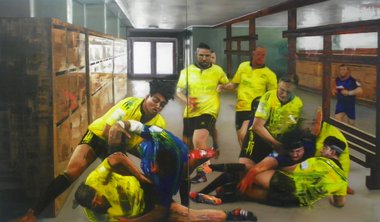
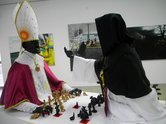



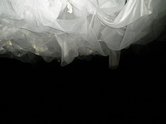

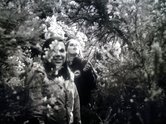
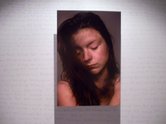

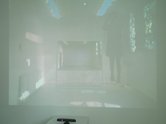
 Two Rooms presents a program of residencies and projects
Two Rooms presents a program of residencies and projects Advertising in this column
Advertising in this column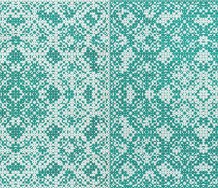
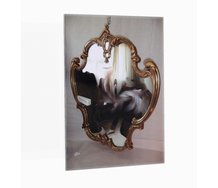
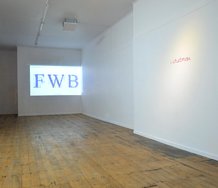
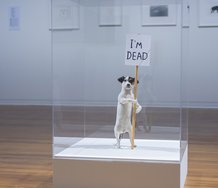
This Discussion has 0 comments.
Comment
Participate
Register to Participate.
Sign in
Sign in to an existing account.